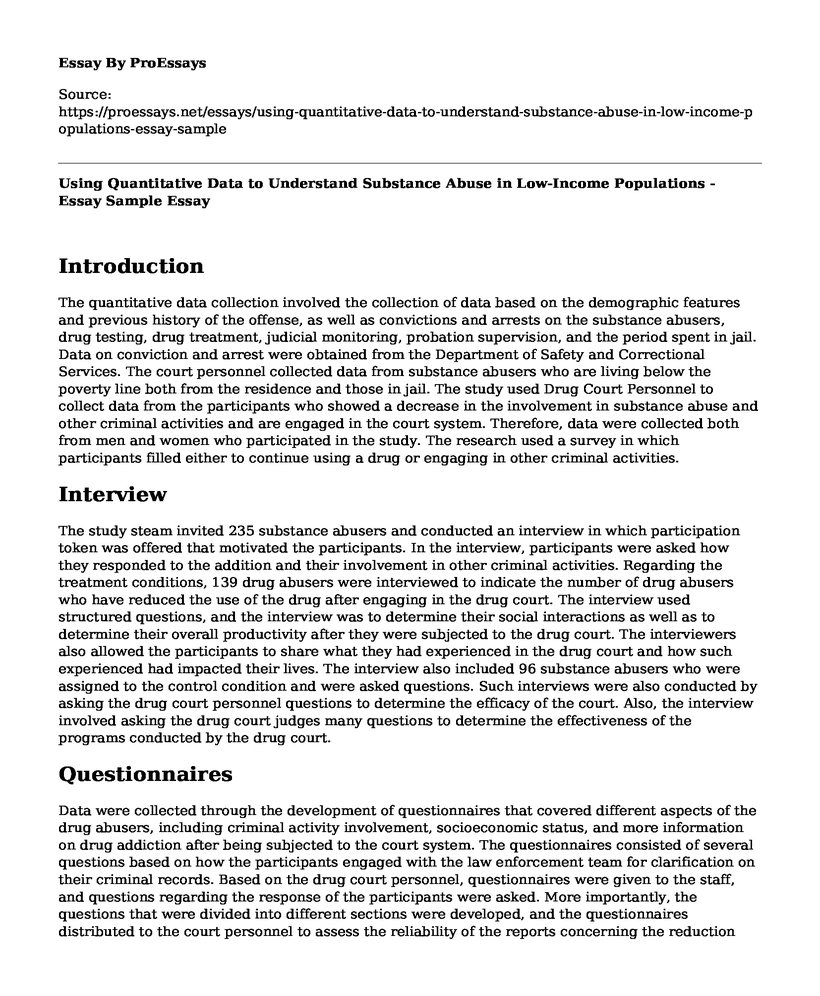Introduction
The quantitative data collection involved the collection of data based on the demographic features and previous history of the offense, as well as convictions and arrests on the substance abusers, drug testing, drug treatment, judicial monitoring, probation supervision, and the period spent in jail. Data on conviction and arrest were obtained from the Department of Safety and Correctional Services. The court personnel collected data from substance abusers who are living below the poverty line both from the residence and those in jail. The study used Drug Court Personnel to collect data from the participants who showed a decrease in the involvement in substance abuse and other criminal activities and are engaged in the court system. Therefore, data were collected both from men and women who participated in the study. The research used a survey in which participants filled either to continue using a drug or engaging in other criminal activities.
Interview
The study steam invited 235 substance abusers and conducted an interview in which participation token was offered that motivated the participants. In the interview, participants were asked how they responded to the addition and their involvement in other criminal activities. Regarding the treatment conditions, 139 drug abusers were interviewed to indicate the number of drug abusers who have reduced the use of the drug after engaging in the drug court. The interview used structured questions, and the interview was to determine their social interactions as well as to determine their overall productivity after they were subjected to the drug court. The interviewers also allowed the participants to share what they had experienced in the drug court and how such experienced had impacted their lives. The interview also included 96 substance abusers who were assigned to the control condition and were asked questions. Such interviews were also conducted by asking the drug court personnel questions to determine the efficacy of the court. Also, the interview involved asking the drug court judges many questions to determine the effectiveness of the programs conducted by the drug court.
Questionnaires
Data were collected through the development of questionnaires that covered different aspects of the drug abusers, including criminal activity involvement, socioeconomic status, and more information on drug addiction after being subjected to the court system. The questionnaires consisted of several questions based on how the participants engaged with the law enforcement team for clarification on their criminal records. Based on the drug court personnel, questionnaires were given to the staff, and questions regarding the response of the participants were asked. More importantly, the questions that were divided into different sections were developed, and the questionnaires distributed to the court personnel to assess the reliability of the reports concerning the reduction cases of substance abuse use as well as other criminal activities among the drug abusers after being subjected to the drug court. Finally, the law enforcement agencies were also supplied with questionnaires in which questions regarding significant records on the use of substances were included and how the participants interacted with them after being subjected to the court system were asked.
Analysis
Intent to Treat Analysis
In this type of analysis, the study treated all the participants as randomized. The study randomly assigned the participants to the control condition and drug court, and analyses were conducted without considering the actual treatment of the participants. The study either factored in neither the withdrawal nor the deviation from the protocol of treatment. Based on the significance of the intent to treat analysis, the type of analysis preserves the baseline comparability of the study group, while other types, including the treated analysis and per-protocol analysis, are all focusing on similar bias and possible confrontation confounds like the observational research. In the intent to treat analysis, treatment effect estimation is highly conservative because of the probability of the treatment dissolution as well as the possibility of migration; hence the type of analysis leads to susceptible results. Concerning the limitation of the intent to treat analysis, different trials demonstrate flaws in collecting the primary data, and the method used in handling such problems are generally poor. Also, the principles of intent to treat analysis are poorly applied and described.
Power Analysis
Before the analysis began, the study conducted a power analysis to assess the statistical power of the current research. The study computed power estimates by assuming two independent groups, including the control and treatment conditions. Both means and standard deviations for the two groups of participants who included men and women who are substance abusers and were subjected to the court system, on the cumulative arrest were utilized in the power calculations in which p-value was taken to be 0.05, the post hoc power was determined to be 0.72, and the standard convention was 0.80. Based on the significance of the power analysis, the analysis assists the researcher in determining the smaller sample size, which is most appropriate for identifying the effect of a certain test. Concerning the limitations of the power analysis, the type of analysis can recommend the smallest sample size than the appropriate size of the procedure.
Cite this page
Using Quantitative Data to Understand Substance Abuse in Low-Income Populations - Essay Sample. (2023, Apr 23). Retrieved from https://proessays.net/essays/using-quantitative-data-to-understand-substance-abuse-in-low-income-populations-essay-sample
If you are the original author of this essay and no longer wish to have it published on the ProEssays website, please click below to request its removal:
- Sociology Essay Example: What Poverty Means
- Utilitarianism and Illegal Abortions Essay Example
- Elderly Homelessness in LA County - Research Paper
- Essay Sample on Homelessness and Stress
- Essay on Developing Poverty Reduction Plan: Engaging Stakeholders & Grassroots Individuals
- Essay Example on Southern Maryland Food Bank: Supplying Bulk Food to Abused Persons
- Biography Sample on Jane Addams: Champion of Peace, Philanthropy, Work Ethic







